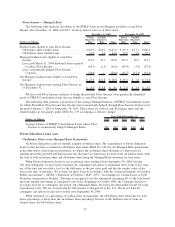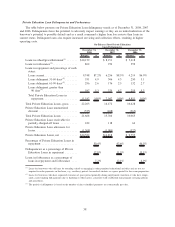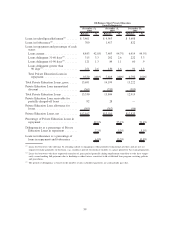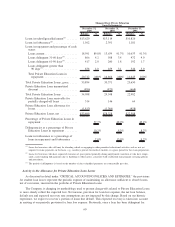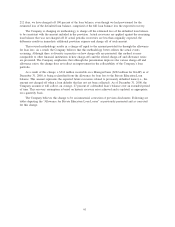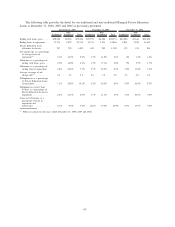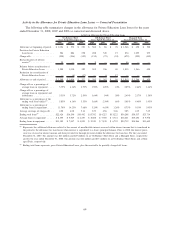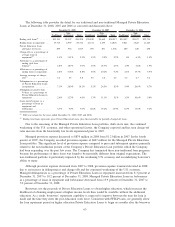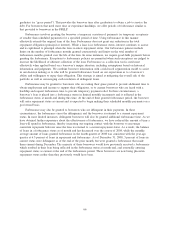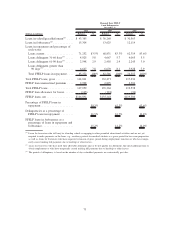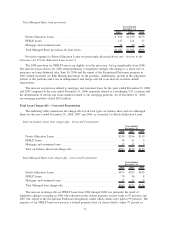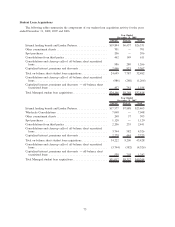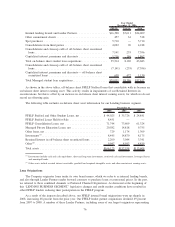Sallie Mae 2008 Annual Report Download - page 67
Download and view the complete annual report
Please find page 67 of the 2008 Sallie Mae annual report below. You can navigate through the pages in the report by either clicking on the pages listed below, or by using the keyword search tool below to find specific information within the annual report.graduates (or “grace period”). This provides the borrower time after graduation to obtain a job to service the
debt. For borrowers that need more time or experience hardships, we offer periods of forbearance similar to
that provided to borrowers in the FFELP.
Forbearance involves granting the borrower a temporary cessation of payments (or temporary acceptance
of smaller than scheduled payments) for a specified period of time. Using forbearance in this manner
effectively extends the original term of the loan. Forbearance does not grant any reduction in the total
repayment obligation (principal or interest). While a loan is in forbearance status, interest continues to accrue
and is capitalized to principal when the loan re-enters repayment status. Our forbearance policies include
limits on the number of forbearance months granted consecutively and limits on the total number of
forbearance months granted over the life of the loan. In some instances, we require good-faith payments before
granting the forbearance. Exceptions to forbearance policies are permitted when such exceptions are judged to
increase the likelihood of ultimate collection of the loan. Forbearance as a collection tool is used most
effectively when applied based on a borrower’s unique situation, including assumptions based on historical
information and judgments. We combine borrower information with a risk-based segmentation model to assist
in our decision making as to who will be granted forbearance based on our expectation as to a borrower’s
ability and willingness to repay their obligation. This strategy is aimed at mitigating the overall risk of the
portfolio as well as encouraging cash resolution of delinquent loans.
Forbearance may be granted to borrowers who are exiting their grace period to provide additional time to
obtain employment and income to support their obligations, or to current borrowers who are faced with a
hardship and request forbearance time to provide temporary payment relief. In these circumstances, a
borrower’s loan is placed into a forbearance status in limited monthly increments and is reflected in the
forbearance status at month-end during this time. At the end of their granted forbearance period, the borrower
will enter repayment status as current and is expected to begin making their scheduled monthly payments on a
go-forward basis.
Forbearance may also be granted to borrowers who are delinquent in their payments. In these
circumstances, the forbearance cures the delinquency and the borrower is returned to a current repayment
status. In more limited instances, delinquent borrowers will also be granted additional forbearance time. As we
have obtained further experience about the effectiveness of forbearance, we have reduced the amount of time a
loan will spend in forbearance, thereby increasing our ongoing contact with the borrower to encourage
consistent repayment behavior once the loan is returned to a current repayment status. As a result, the balance
of loans in a forbearance status as of month end has decreased over the course of 2008, while the monthly
average amount of loans granted forbearance in the fourth quarter of 2008 was consistent with the year-ago
quarter at 6.5 percent of loans in repayment and forbearance. As of December 31, 2008, 3 percent of loans in
current status were delinquent as of the end of the prior month, but were granted a forbearance that made
them current during December. The majority of these borrowers would have previously received a forbearance
which resulted in their loan being reflected in the forbearance status at month end, and eventually entering
repayment status as current at the end of the forbearance period. These borrowers are now being placed in
repayment status earlier than they previously would have been.
66



